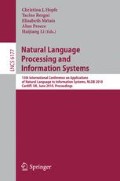Abstract
The geographic database (GDB) is the backbone of the geographic information system (GIS). Indeed, all kinds of data managements are based and strongly affected by the type, relevancy and scope of the stored data. Nevertheless, this dataset is sometimes insufficient to make the adequate decision. Then, it is of primary interest to provide other data sources to complement the inherent GDB. In this context, we propose a four staged semantic data enrichment approach consisting of: text segmentation, theme identification, delegation and text filtering. Besides, a refinement is eventually executed to enhance the data enrichment results.
Access this chapter
Tax calculation will be finalised at checkout
Purchases are for personal use only
Preview
Unable to display preview. Download preview PDF.
References
Pornon, H.: Systèmes d’information géographique, pouvoir et organisations, Géomatique et stratégies d’acteurs, p. 254. Harmattan, Paris (2001)
MetaCarta: MetaCarta Document Templates Integrator’s Guide March 13 (2008)
Lesbegueries, J., Gaio, M., Loustau, P.: Geographical information access for non-structured data. In: ACM Symposium on Applied Computing (SAC), Dijon, France, pp. 83–89 (2006)
Hyland, R., Clifton, C., Holland, R.: GeoNODE: Visualizing News in Geospatial Environments. In: Proceedings of the Federal Data Mining Symposium and Exhibition 1999, AFCEA, Washington D.C (1999)
Crane, G.: The Perseus Project and the Problems of Digital Humanities. In: Standards und Methoden der Volltextdigitalisierung Trier. Mainz Academy, Germany (2001)
Mahmoudi, K., Faïz, S.: Un processus d’acquisition d’information pour les besoins d’enrichissement des BDG. Revue des Nouvelles Technologies de l’Information (RNTI), pp. 691–696. Editions Cepaduès (2008)
Ferber, J.: Les Systèmes Multi-Agents vers une intelligence collective. Edition InterEditions, p. 522 (1997)
Hearst, M.: Texttiling: Segmenting text into multi-paragraph subtopic passages. Computational Linguistics 23(1), 33–64 (1997)
Choi, F.Y.Y.: Advances in independent linear text segmentation. In: Proceedings of the 1st Meeting of the North American Chapter of the Association for Computational Linguistics (ANLP-NAACL 2000), pp. 26–33 (2000)
Fellbaum, C.: WordNet: An Electronic Database. MIT Press, Cambridge (1998)
Mann, W., Thompson, S.A.: Rhetorical structure theory: Toward a functional theory of text organization. Text 8(3), 243–281 (1988)
Tobler, W.R.: A Computer Movie Simulating Urban Growth in Detroit Region. Economic Geography 46, 234–240 (1970)
Bestgen, Y., Piérard, S.: Comment évaluer les algorithmes de segmentation automatique? Essai de construction d’un matériel de référence. In: TALN 2006, Leuven, pp. 10–13 (2006)
Pevzner, L., Hearst, M.: A critique and improvement of an evaluation metric for text segmentation. Computational Linguistics 28(1), 19–36 (2002)
Hovy, E., Lin, C.Y., Zhou, L.: Automated summarization evaluation with basic elements. In: Proc. of the 5th International Conference on Language Resources and Evaluation (2006)
Marcu, D.: Discourse trees are good indicators of importance in text. In: Mani, I., Maybury, M. (eds.) Advances in Automatic Text Summarization, pp. 123–136 (1999)
Radev, D., Otterbacher, J., Qi, H., Tam: MEAD reducs: Michigan at DUC 2003, pp. 160–167. ACL, Edmonton (2003)
Larson, R.R.: Geographical Information Retrieval and Spatial Browsing. In: Geographical Information Systems and Libraries: Patrons, Maps, and Spatial Information, pp. 81–124 (1996)
Author information
Authors and Affiliations
Editor information
Editors and Affiliations
Rights and permissions
Copyright information
© 2010 Springer-Verlag Berlin Heidelberg
About this paper
Cite this paper
Mahmoudi, K., Faïz, S. (2010). Towards Geographic Databases Enrichment. In: Hopfe, C.J., Rezgui, Y., Métais, E., Preece, A., Li, H. (eds) Natural Language Processing and Information Systems. NLDB 2010. Lecture Notes in Computer Science, vol 6177. Springer, Berlin, Heidelberg. https://doi.org/10.1007/978-3-642-13881-2_22
Download citation
DOI: https://doi.org/10.1007/978-3-642-13881-2_22
Publisher Name: Springer, Berlin, Heidelberg
Print ISBN: 978-3-642-13880-5
Online ISBN: 978-3-642-13881-2
eBook Packages: Computer ScienceComputer Science (R0)

